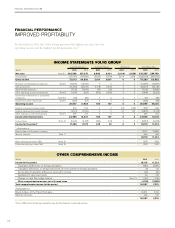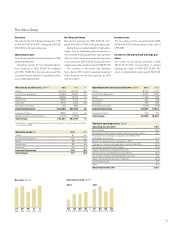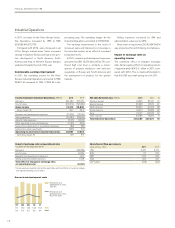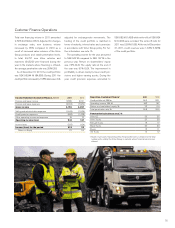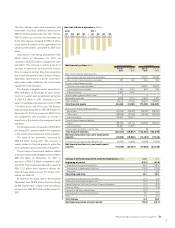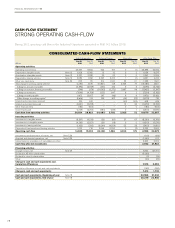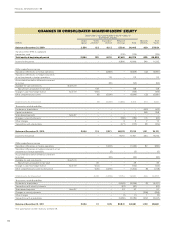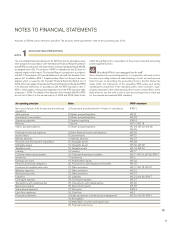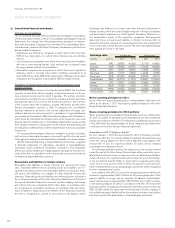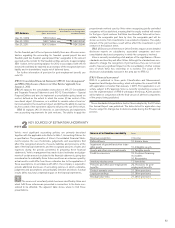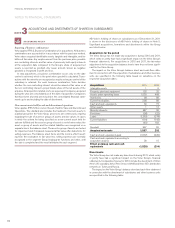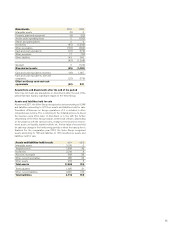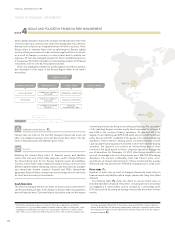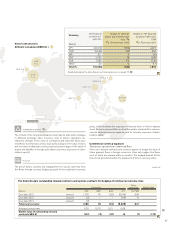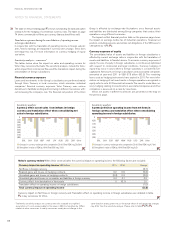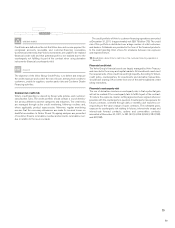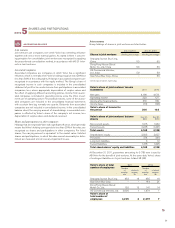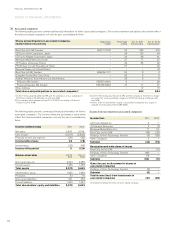Volvo 2011 Annual Report Download - page 86
Download and view the complete annual report
Please find page 86 of the 2011 Volvo annual report below. You can navigate through the pages in the report by either clicking on the pages listed below, or by using the keyword search tool below to find specific information within the annual report.
Consolidated financial statements
Principles for consolidation
The consolidated financial statements have been prepared in accordance
with the principles set forth in IAS 27, Consolidated and Separate Financial
Statements. Accordingly, intra-Group transactions and gains on transac-
tions with associated companies are eliminated. The consolidated finan-
cial statements comprise the Parent Company, subsidiaries, joint ventures
and associated companies.
– Subsidiaries are defined as companies in which Volvo holds more than
50% of the voting rights or in which Volvo otherwise has a controlling
interest.
– Joint ventures are companies over which Volvo has joint control together
with one or more external parties. Joint ventures are recognized using
the proportionate method of consolidation.
– Associated companies are companies in which Volvo has a significant
influence, which is normally when Volvo’s holdings correspond to at
least 20% but less than 50% of the voting rights. Holdings in associated
companies are recognized in accordance with the equity method.
Translation to Swedish kronor when consolidating companies using
foreign currencies
AB Volvo’s functional currency is the Swedish krona (SEK). The functional
currency of each Volvo Group company is determined based on the pri-
mary economic environment in which it operates. The primary economic
environment is normally the one in which the company primarily generates
and expends cash. In most cases, the functional currency is the currency
of the country where the company is located. AB Volvo’s and the Volvo
Group’s presentation currency is SEK. In preparing the consolidated
financial statements, all items in the income statements of foreign sub-
sidiaries and joint ventures (except for subsidiaries in hyperinflationary
economies) are translated to SEK at monthly exchange rates. All balance-
sheet items are translated at exchange rates at the respective year-ends
(closing rate). The differences in consolidated shareholders’ equity, arising
from variations between closing rates for the current and preceding year
are charged or credited directly to other comprehensive income as a separate
component.
The accumulated translation difference related to a certain subsidiary,
joint venture or associated company is reversed to profit or loss as a part
of the gain/loss arising from the divestment or liquidation of such a company.
IAS 29, Financial Reporting in Hyperinflationary Economies, is applied
to financial statements of subsidiaries operating in hyperinflationary
economies. Volvo’s method of recognition is based on cost. Translation
differences due to inflation are charged against earnings for the year. Cur-
rently, Volvo has no subsidiaries with a functional currency that could be
considered a hyperinflationary currency.
Receivables and liabilities in foreign currency
Receivables and liabilities in foreign currency are measured at closing
rates. Translation differences on operating assets and liabilities are rec-
ognized in operating income, while translation differences arising in finan-
cial assets and liabilities are charged to other financial income and
expenses. Financial assets and liabilities are defined as items included in
the net financial position of the Volvo Group (see Definitions at the end of
this report). Derivative financial instruments used for hedging of exchange
and interest risks are recognized at fair value. Gains on exchange rates
are recognized as receivables and losses on exchange rates are recog-
nized as liabilities. Depending on the lifetime of the financial instrument,
the item is recognized as current or non-current in the balance sheet.
Exchange rate differences on loans and other financial instruments in
foreign currency, which are used to hedge net assets in foreign subsidiaries
and associated companies, are offset against translation differences in
the shareholders’ equity of the respective companies. Exchange-rate
gains and losses on assets and liabilities in foreign currencies, both on
payments during the year and on measurements at year-end, impact profit
or loss in the year in which they are incurred. The more important exchange
rates applied are shown in the table.
Exchange rates Average rate Closingrate
Country Currency 2011 2010 2011 2010
Brazil BRL 3.8850 4.0925 3.7109 4.0560
Canada CAD 6.5694 6.9973 6.7808 6.8085
China CNY 1.0057 1.0643 1.0998 1.0300
Denmark DKK 1.2137 1.2823 1.2044 1.2086
Euro zone EUR 9.0430 9.5502 8.9540 9.0113
Great Britain GBP 10.4179 11.1319 10.6831 10.5538
Japan JPY 0.0817 0.0823 0.0892 0.0835
Norway NOK 1.1596 1.1926 1.1515 1.1530
South Korea KRW 0.0059 0.0062 0.0060 0.0060
United States USD 6.4982 7.2060 6.9247 6.8038
New accounting principles for 2011
None of the new accounting principles or interpretations that came into
effect as of January 1, 2011 has had any significant impact on the Volvo
Group’s financial statements.
New accounting principles for 2012 and later
When preparing the consolidated financial statements as of December
31, 2011, a number of standards and interpretations has been published,
but has not yet become effective. The following is a preliminary assessment
of the effect that the implementation of these standards and statements
could have on the Volvo Group’s financial statements.
Amendment to IAS 19 Employee benefits*
As from January 1, 2013 the amendment to IAS 19, Employee benefits
will become effective. The revised standard is applied retrospectively, and
hence the closing balance for 2011 will be adjusted in accordance with
revised IAS 19 and the reported numbers for 2012 will be restated
accordingly for comparison reason.
The amended standard removes the option to use the corridor method
currently used by the Volvo Group. Discount rate will be used when calcu-
lating the net interest income or expense on the net defined benefit liabil-
ity (asset), hence the expected return will no longer be used. All changes
in the net defined benefit liability or asset will be recognized when they
occur. Service cost and net interest will be recognized in profit and loss
while remeasurements such as actuarial gains and losses will be recognized
in other comprehensive income.
In accordance with IAS 19 revised, the recognized pension liability will
increase by approximately SEK 12 billion as the unrecognized part of the
pension liability no longer can be reported off balance. Shareholders’
equity will decrease by approximately SEK 8 billion net of deferred taxes
in the opening balance for 2012 in accordance with IAS 19 revised. Net
financial position including post-employment benefits would increase by
SEK 12 billion while the equity ratio would decrease. Further changes in
the net defined benefit liability will be the modified net interest calculation
and the removal of the amortisation of actuarial gains and losses.
NOTES TO FINANCIAL STATEMENTS
FINANCIAL INFORMATION 2011
82


